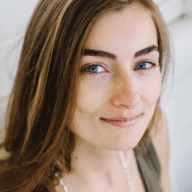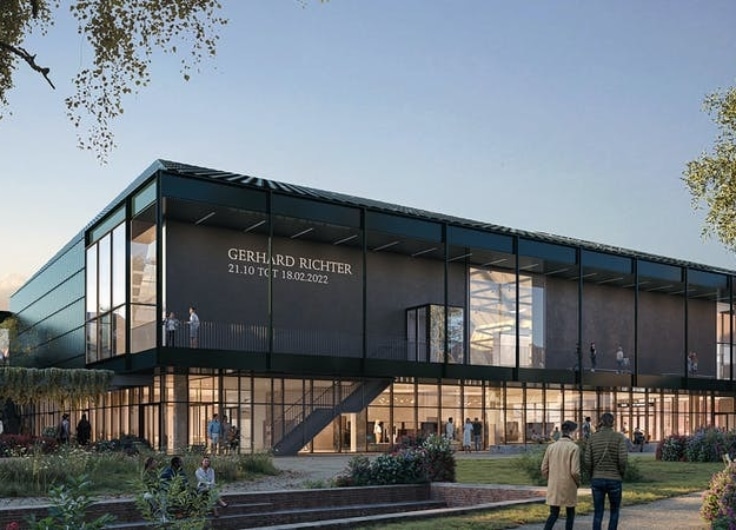Triennial Bruges 2021: Face Your Fears and Dream Big During an Artistic Exploration of Fantasy and Reality
On 8 May , the Bruges Triennial descended on the historic city for a third time. Up until 24 October 2021, you can explore creations by thirteen artists and architects, who all took inspiration from TraumA –not surprisingly, the title of this year’s triennial. ‘TraumA’ as a title comprises many layers: based on the German version of the word, it might invoke ‘dream’, ‘space’ or ‘trauma’. In doing so, the triennial navigates through dreams and nightmares, moves between what is present and what is not, and what is inside and out.
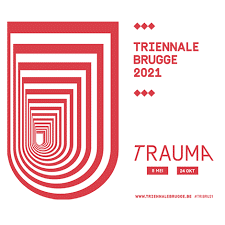
First things first: start out by picking up a map featuring all locations along the city route from the Porter’s Lodge (Poortersloge). The map provides information about the route as well as the opening hours of the indoor locations, where some of the installations can be found. Although you can find all of this this info online, I have come to appreciate a bit of analogue data and interaction. Moreover, you have to be here anyway for a visit to the The Porous City (De poreuze stad) exhibit.
This exhibition is an excellent starting point, as it features some forty artworks by various artists. The names of Jana Cordenier, Thierry De Cordier, Joëlle Dubois, Kendell Geers, Hermann Nitsch, Ana Torfs and Filip Vervaet immediately catch your eye. However, what truly stood out for me personally, were Bilal Bahir’s drawings, Semâ Bekirović gigantic thermometers, Enrique Marty’s intimidating figures, Julie Villard and Simon Brossard’s futuristic sculpture and Nomad, the seemingly soft creation by Gavin Turk.
Constructive vertigo
Next, I decide to head out to the locations farthest from the city centre. After a ten-minute walk, I come across Strangler by Héctor Zamora – quite a surprising sculpture. Or rather: ‘construction’. A monumental fluorescent orange scaffolding structure wraps around a strapping tree in the garden of the Guido Gezelle House (Gezellehuis). A staircase leads to the very peak of the tall Austrian pine tree. It soon becomes apparent how this artwork relates to the overall theme; a little vertigo is never far away when climbing to the top. The scaffolding mimics a creeper species, known to absorb all the host tree’s energy. When said host tree dies, the creepers happily live on. Thanks to the human intervention that is Strangler, however, the tree is preserved and even enhanced: owing to the scaffolding, you can both enjoy the beauty of nature and a splendid view of Bruges and its surroundings.
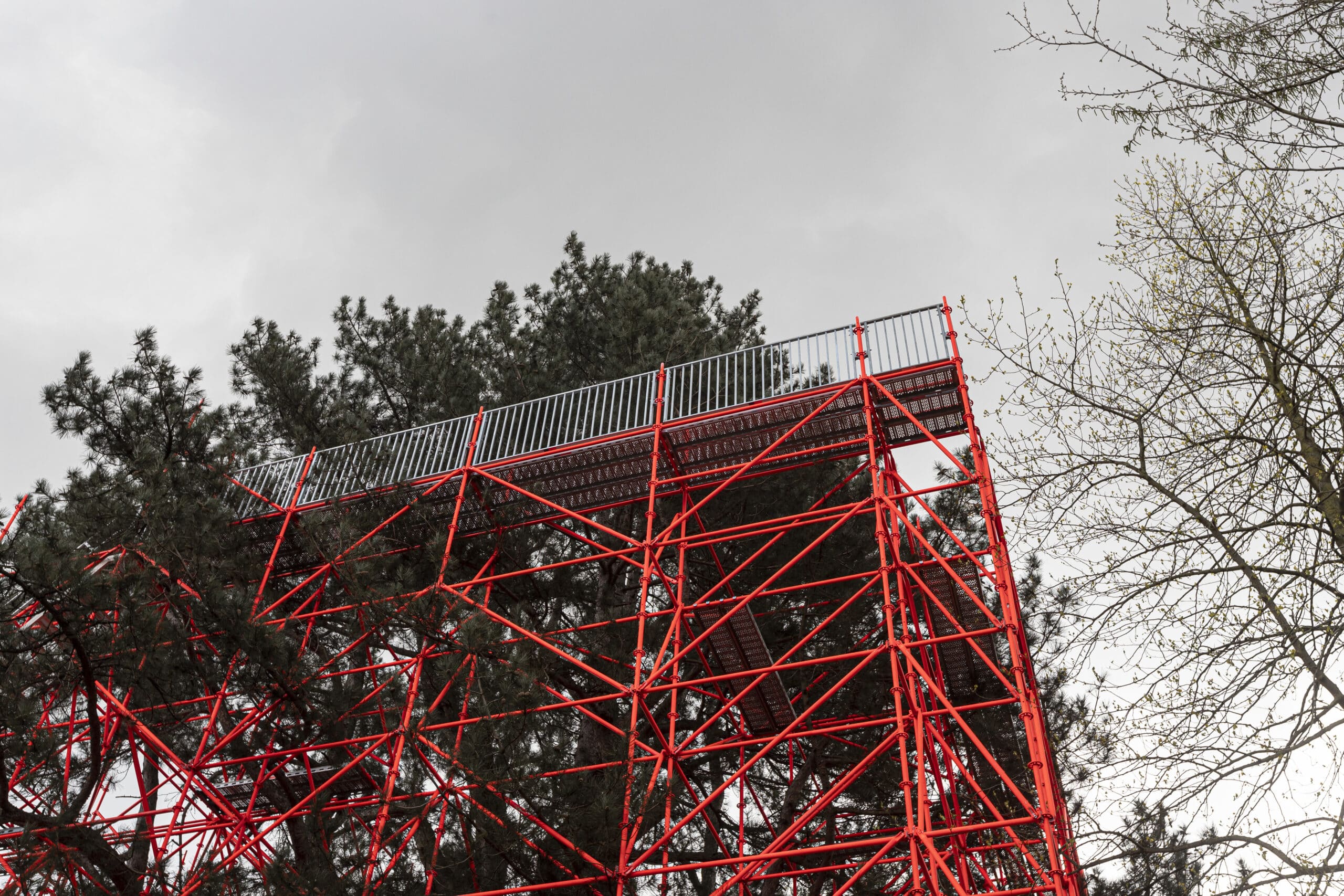 Héctor Zamora, Strangler, 2021, Labor, Mexico; Luciana Brito Galeria, São Paulo; Albarrán Bourdais, Madrid - Triennial Bruges 2021
Héctor Zamora, Strangler, 2021, Labor, Mexico; Luciana Brito Galeria, São Paulo; Albarrán Bourdais, Madrid - Triennial Bruges 2021© Stad Brugge - Matthias Desmet
Then, I make my way to the Potterierei. There, you can admire work by Laura Splan and Gregor Schneider. Unless you accidentally take a detour, it should take you about eleven minutes. What stayed with me most when it comes to Laura Splan, were her lace sculptures based on virus structures. This sophisticated medium’s reference to both Bruges and the coronavirus is at once adorable, extraordinary, and powerful. Furthermore, I do appreciate the contrast between this traditional craft and contemporary art.
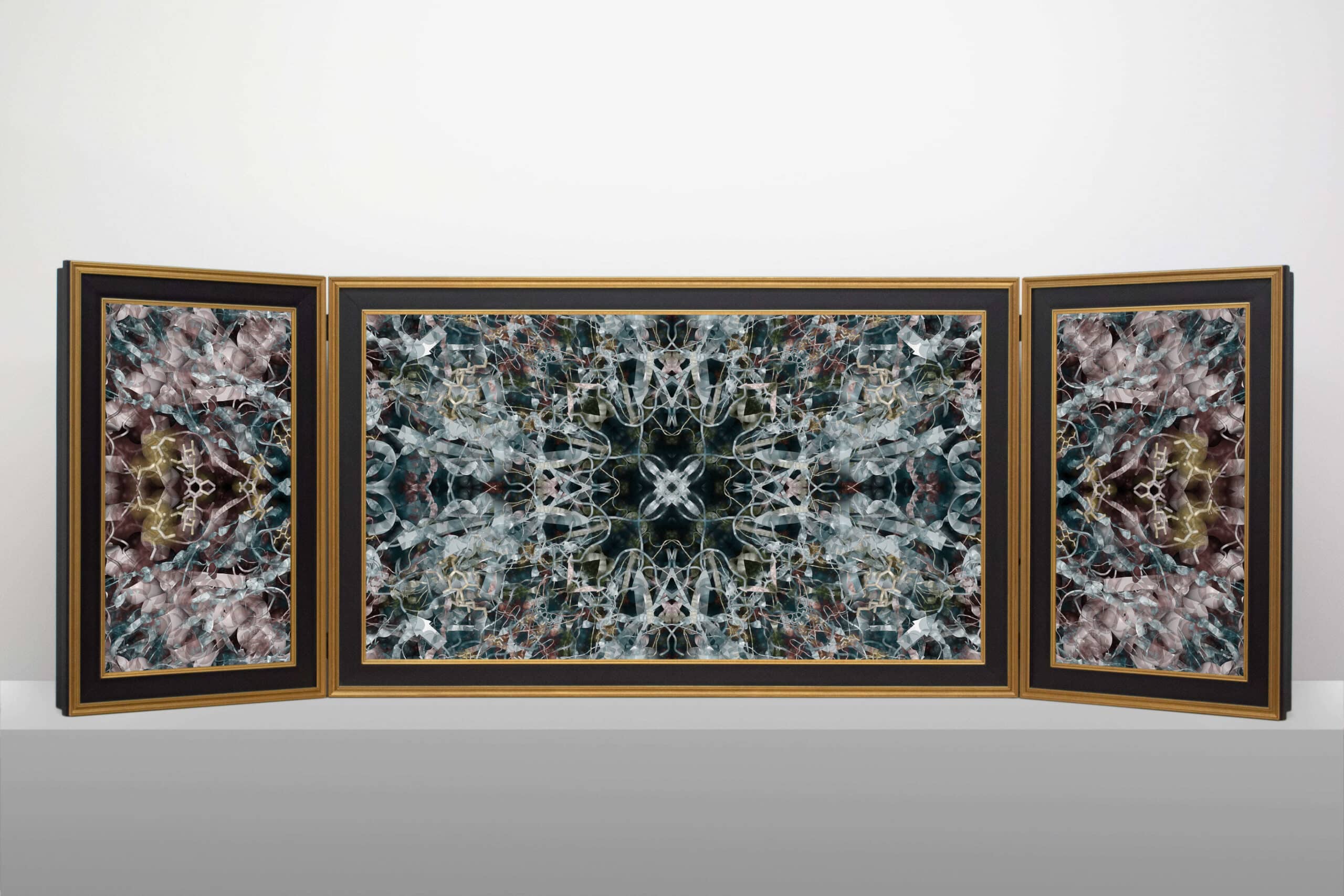 Laura Splan, Disentanglement, 2021
Laura Splan, Disentanglement, 2021© Laura Splan
In the Major Seminary (Grootseminarie), I come face with Black Lightning by Gregor Schneider. To be honest, I like to educate myself as little as possible before going to an exhibition. This enables to me to experience optimal surprise. And this work of art achieved just that. Please jump to the paragraph below should you want that same clueless encounter. This installation is set in complete darkness. You have to feel your way out. Fortunately, the walls are cushioned, and it is impossible to get lost. The panic-stricken side of me initially demands me to turn around on the spot and make my way out through the front entrance. But I don’t. I must stay the course. Quite the effort for an exhibition meandering between trauma, dream, reality, and space perception! You should definitely make an extra effort to visit Colonnade by Gijs Van Vaerenbergh. This robust yet elegant labyrinth will not disappoint. Is it a house, a sculpture, or a monument – What do you think?
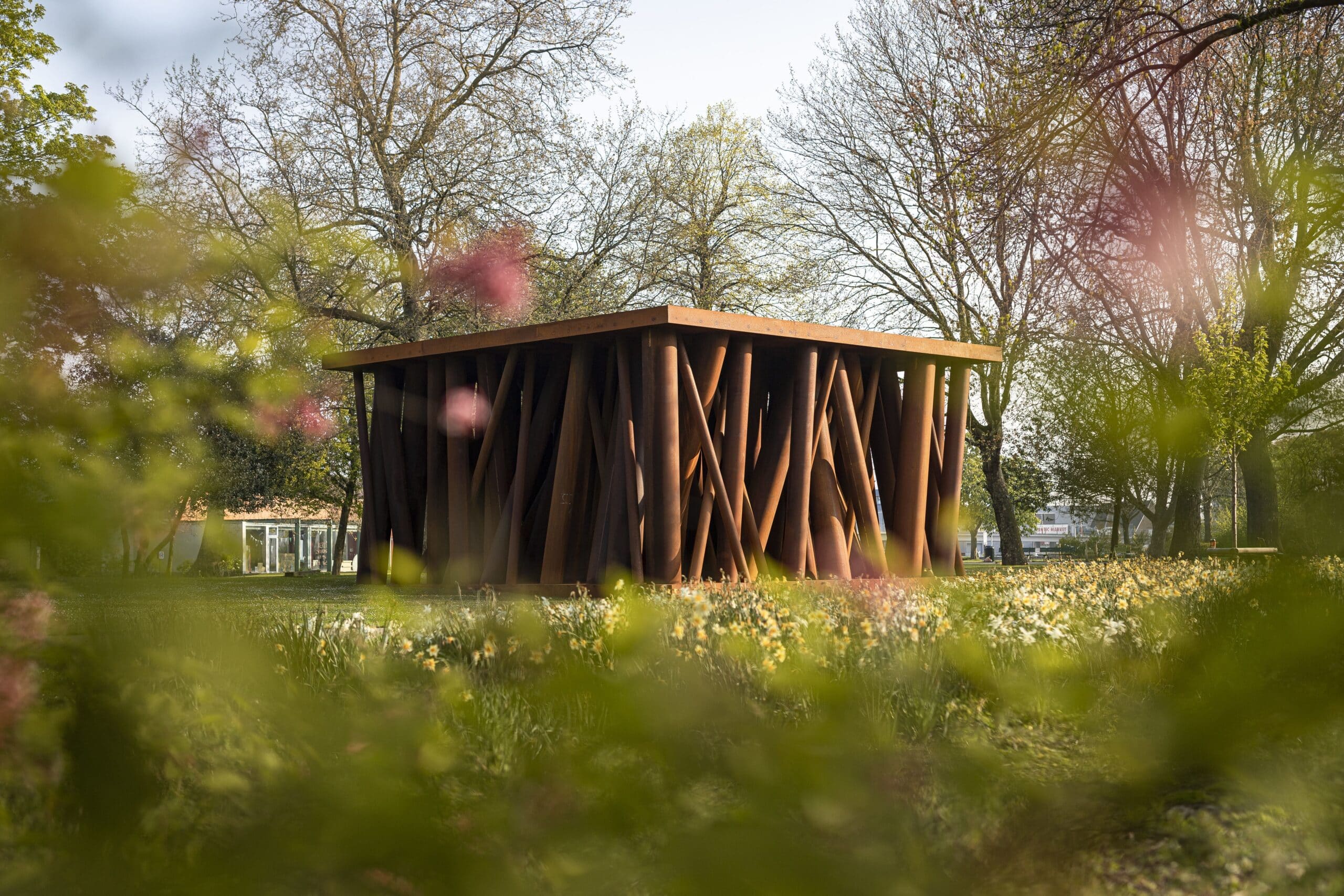 Gijs Van Vaerenbergh, Colonnade, Triennial Bruges 2021
Gijs Van Vaerenbergh, Colonnade, Triennial Bruges 2021© Stad Brugge - Matthias Desmet
Art or building site?
I head back to the city centre. Along three adjacent canals, you can admire The Bruges Diptych by Jon Lott (Gouden-Handrei), Les Niches Parties by Nadia Naveau (Augustijnenrei) and Banisteria Caapi [Desnatureza 4] by Henrique Oliveira (Pottenmakersstraat – admittedly, this is not a canal, but along the water nevertheless). According to the plaque, Jon Lott’s artwork has just arrived, but I’m not entirely convinced it is finished. According to the description it is an architectural diptych, consisting of Lott’s construction site on the water and the existing house behind it. One copies the other and this work is therefore a play on what you wouldn’t normally be able to lay eyes on from the historical city, i.e., the interiors.
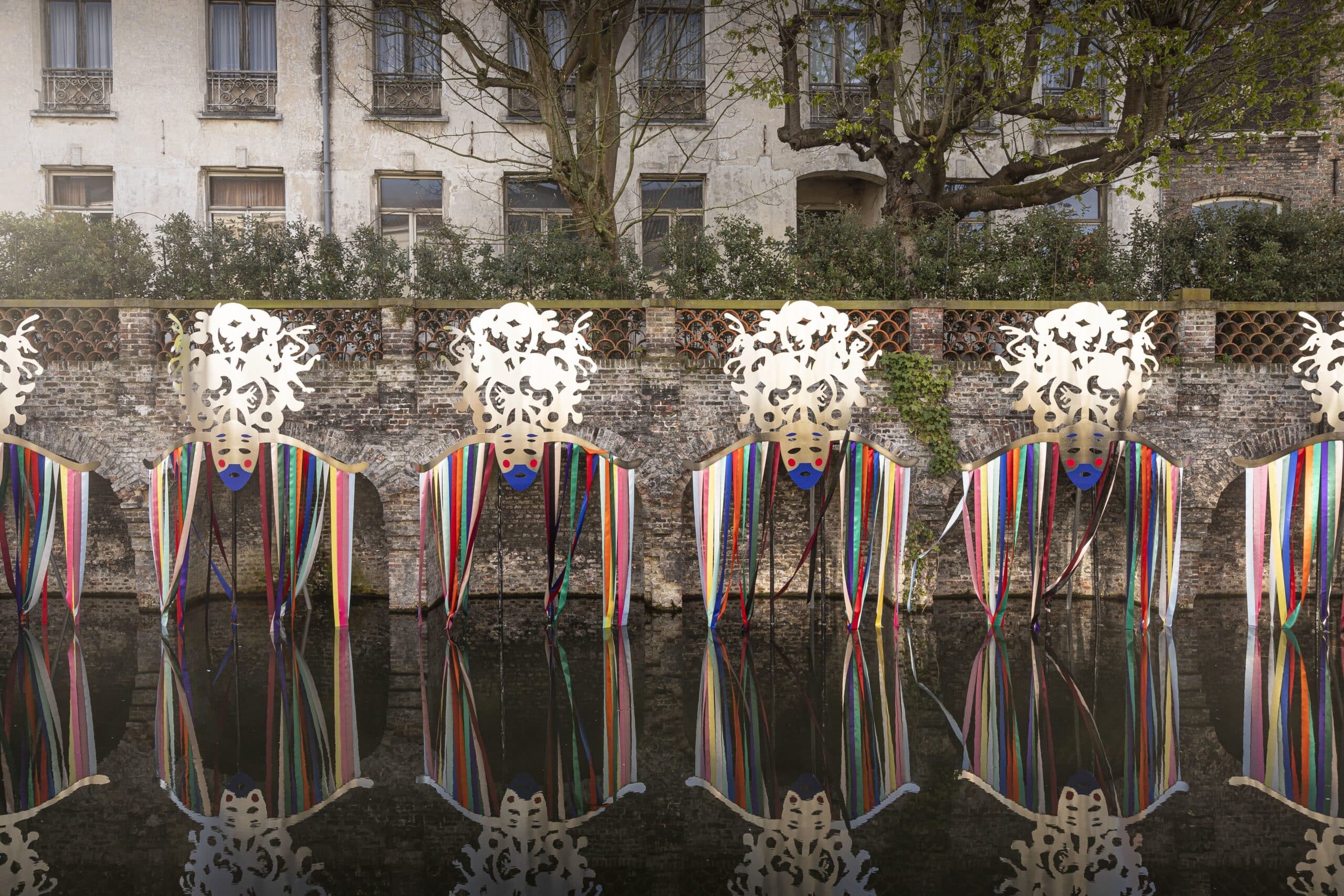 Nadia Naveau, Les Niches Parties, 2021, Base-Alpha Gallery, Antwerp
Nadia Naveau, Les Niches Parties, 2021, Base-Alpha Gallery, Antwerp© Triennial Bruges - Matthias Desmet
There is no doubt about it: we will be seeing a lot of Henrique Oliveira’s sculpture on Instagram – and rightly so. Its ‘roots’ seem to have been growing there for as long as the medieval walls they are covering have been around. An unsuspecting passer-by might even mistake the artwork for a natural phenomenon, although it is actually made from multiplex. Is what we see always reality? Moreover, the semi-circular tower is a remnant of Bruges oldest stone ramparts, part of the city’s lesser-known remnants. This is where I take my first break from the walk, while scanning the QR code you can find on each of the plaques. It turns out I should have done this sooner: you see, the codes take you to Spotify for spoken background information on both the artwork and the artists.
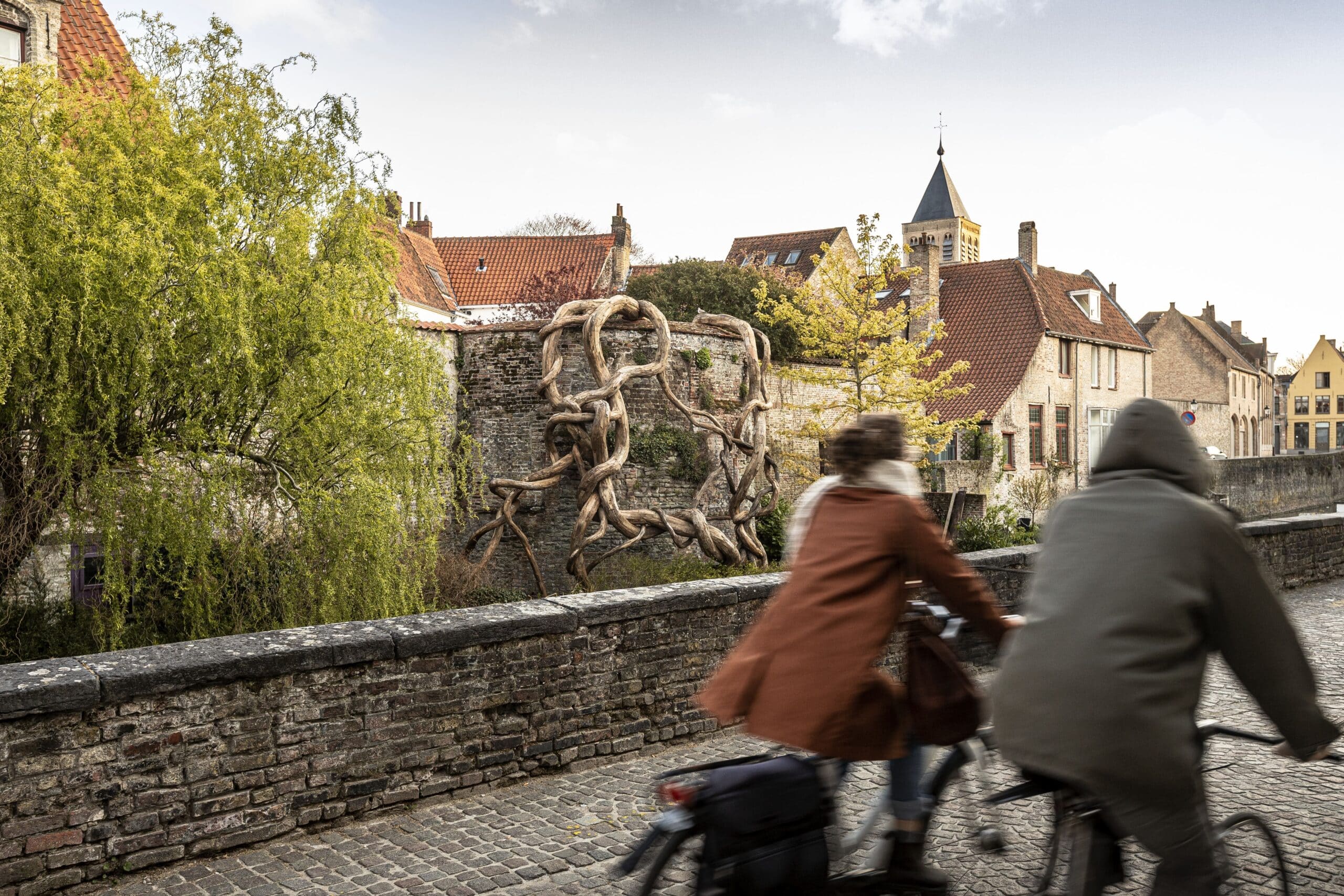 Henrique Oliveira, Banisteria Caapi (Desnatureza 4), 2021, Vallois, Paris; Van de Weghe, New York
Henrique Oliveira, Banisteria Caapi (Desnatureza 4), 2021, Vallois, Paris; Van de Weghe, New York© Triennial Bruges - Jasper van het Groenewoud
On my way to the very heart of the city centre, I first happen upon Happy Coincidences by Amanda Browder. To create this gigantic collage, she enlisted the help of the inhabitants of Bruges to collect pieces of fabric. Every little piece of textile represents a personal story. This way, Browder’s creative process brings people together. In addition, she transforms bits of fabric and memories that used to be rather private into a public and accessible work of art. Furthermore, the location of Happy Coincidences is not quite as coincidental as the title might suggest. In fact, in the Middle Ages, the dyers used to gather at the Verversdijk to dye the cloth.
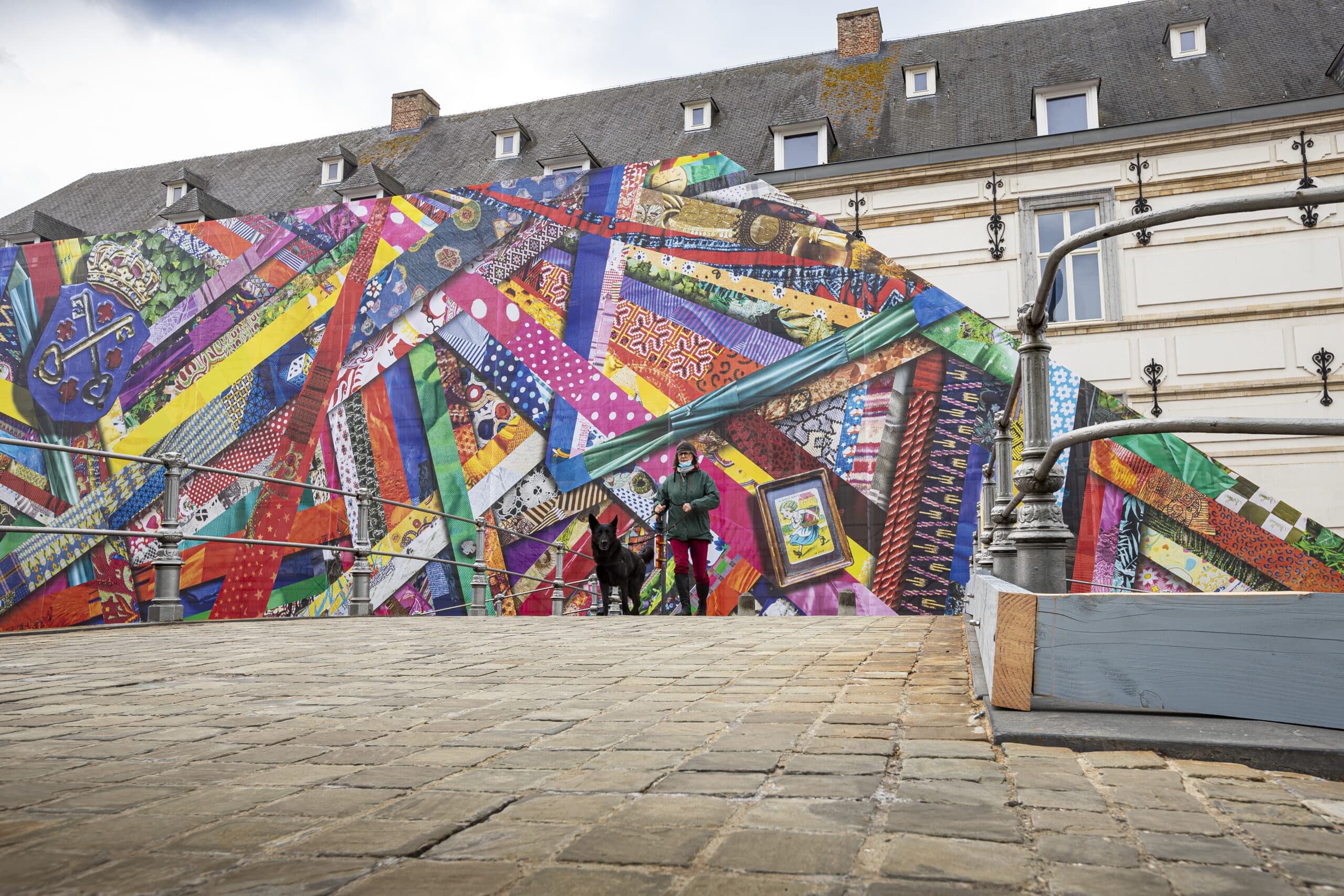 Amanda Browder, Happy Coincidences, Triennial Bruges 2021
Amanda Browder, Happy Coincidences, Triennial Bruges 2021© Stad Brugge - Matthias Desmet
Sharp contrasts
Nadia Kaabi-Linke’s Inner Circle, which is located on the Burg Square, is in stark contrast to the tactility of Browder’s fabrics. Using sharp pins, she transforms public benches into hostile objects. We are driven from this place of relaxation as though we were pigeons. We can imagine several levels on which this artwork relates to TraumA. However, the artist is mainly concerned with criticising those social circles that like to hide problems behind closed doors. In other words: trauma in private spaces. The circular shape refers to family structures, professional situations and labour contexts, or exclusive clubs and privileged communities that tend to use circles in their logos. Form and content are equally painful.
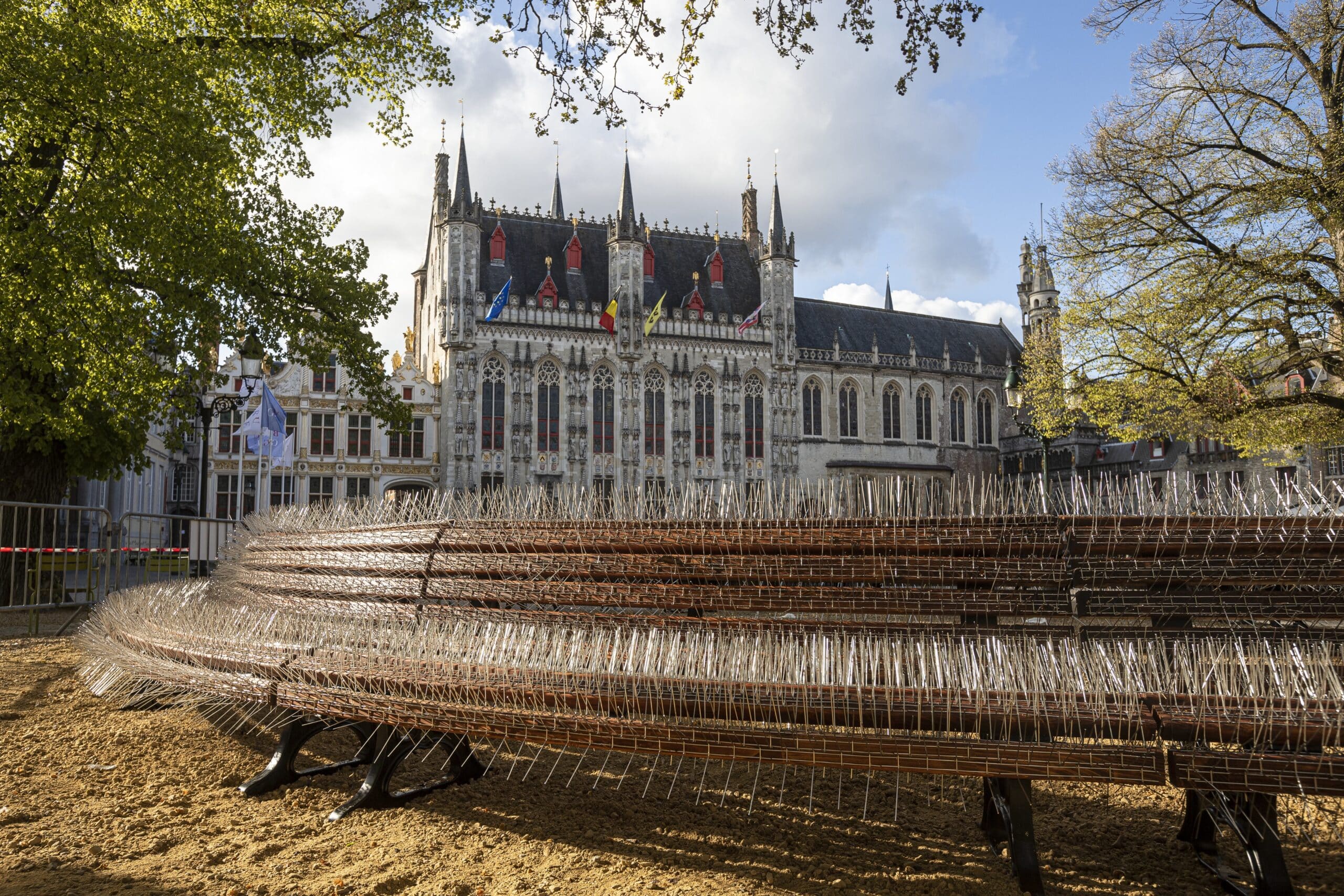 Nadia Kaabi-Linke, Inner Circle, Triennial Bruges 2021
Nadia Kaabi-Linke, Inner Circle, Triennial Bruges 2021© Stad Brugge - Matthias Desmet
Across the city, visitors can discover Adrián Villar Rojas’ bird’s nests. The tiny sculptures made from mud, clay, and twigs, among other things, can be spotted atop monuments, or hanging from façades and poles. At least, that’s how the story goes… Unfortunately, I couldn’t locate any myself. But I’ll make sure to keep my eyes peeled next time I find myself in Bruges. I conclude my tour of the Bruges Triennial with Who is afraid of Natacha? by Joanna M and CT Jasper in the Beguinage (Begijnhof) and And the World Keeps Turning by Nnenna Okore. Okore wrapped the Gunpowder Tower (Poertoren) in large, red, organic circular shapes. The circles are inspired by lacemaking and their red colour by the traditional local brick façades. This is a true eyecatcher, dominating and absorbing part of the city, while simultaneously drawing attention to the building. Yet another artwork that is full of contrasts.
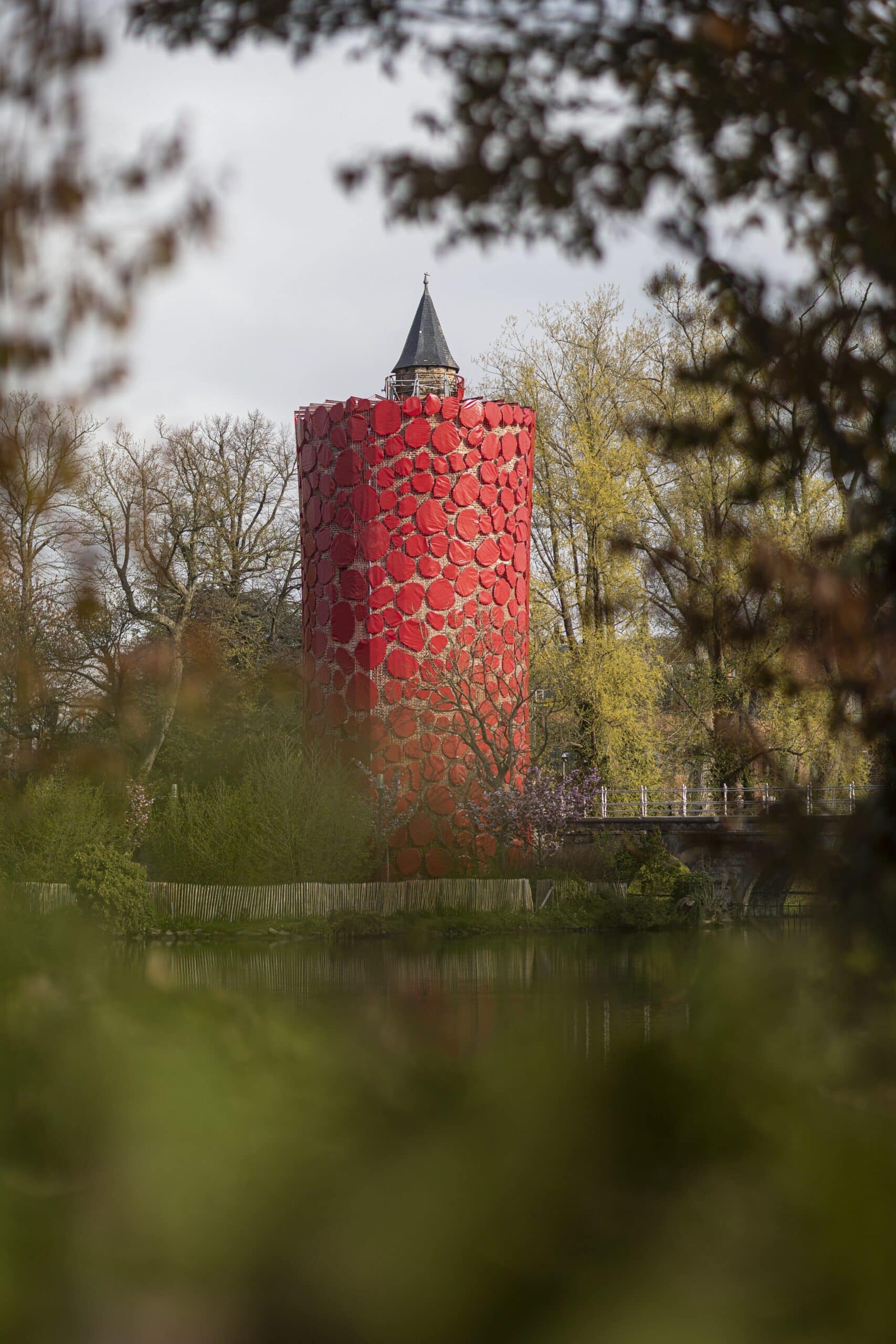 Nnenna Okore, And the World Keeps Turning, Triennial Bruges 2021
Nnenna Okore, And the World Keeps Turning, Triennial Bruges 2021© Stad Brugge - Matthias Desmet
Once again, the Bruges Triennial manages to bring together a series of wonderful artists, all of whom are able to give life to the theme and each of its many layers. Every single artist accomplished this in his or her own particular way. Where, for instance, Gregor Schneider or Héctor Zamora clearly confront visitors with their fears, other dimensions – space, dream, reality versus truth – are expressed in a far subtler way elsewhere. Alternating between large-scale eyecatchers and more intimate, or hidden, artworks creates a rhythm that allows for wonderment. You are free to explore the route in one go or discover it during a couple of visits to Bruges. In any case, Hans Op de Beeck’s Danse Macabre, which I’m particularly excited about, is still under construction. Bruges can therefore expect me for a return visit very soon.

